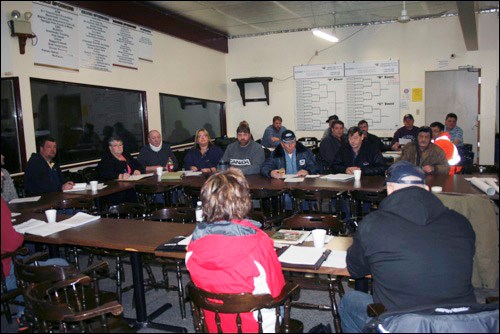The Rural Municipality of Blaine Lake hosted a flood preparedness meeting March 4 at the Blaine Lake Curling Rink.
The surrounding municipalities, villages and First Nations were in attendance to recognize the potential for flooding this spring.
Presentations identifying potential 'trouble' areas were made by the Town and RM of Blaine Lake, Village of Marcelin, Muskeg Lake Cree Nation and Village and RM of Leask.
Water table levels have been recorded as the highest in decades creating surface water issues. Some rural municipalities have had lakes and sloughs draining all winter, a clear indication of what is yet to come once spring thaw approaches.
Duane Hiebert of the Saskatchewan Office of the Fire Commission identified that there may be some potential risk areas experiencing either high water or actual flooding this spring. Hiebert mentioned that the Fire Commission services are available to provide equipment and assist with developing response plans as the community requests.
The Department of Highways gave a brief presentation regarding the current work on the culvert underlying Highway 12 south of Blaine Lake. Preparation is underway to ensure that when spring melt occurs, the Q50-100 pipe capacity of the culverts will be able to handle the flow of water. The project has an estimated cost of $350,000.
Al Keller and Ron Crush representing the Saskatchewan Watershed Authority offered valuable information regarding flooding, liability, deterring water flow and protecting infrastructure. Rural municipalities are encouraged to identify the potential flood areas, address the issue in a proactive manner to reduce damage to infrastructure and land while keeping in mind the liability issues.
Rural municipalities are expected to take responsibility, act in a proactive manner and show due diligence, explained Crush.
"You, the RM, must lead by example and coach and guide your ratepayers," he said.
The Saskatchewan Watershed Authority and the Ministry of Corrections, Public Safety and Policing are administering an Emergency Flood Damage Reduction Program to assist communities and rural residents in preparing for flooding this spring. The purpose of the program is to implement emergency flood damage reduction or prevention measures for spring 2011 for communities, rural municipalities and individual farm and country residences.
The program will provide technical and financial assistance to protect homes and permanent structures. One major important aspect of protecting citizens and providing security is to provide testing and analysis services for private potable ground water supplies that may have been affected by flood waters. There are a list of regulations and conditions for the program so interested individuals are encouraged to contact the Watershed Authority regional offices or visit the watershed website at www.swa.ca or the Ministry of corrections, Policing and Public Safety website at www.cpsp.gov.sk.ca/SaskEMO.
Kelly Rempel and Bill Chappell of Ducks Unlimited identified DU as a major landowner along roadway infrastructure within a few of the affected rural municipalities.
DU did purchase land with a purpose in mind but will not stand in the way of public safety explained Rempel. Any projects affecting DU land will need to be defined and presented to DU for analysis and the organization will work proactively to ensure the issue is addressed and rectified keeping the best interests of all parties in mind.
Michael Rathwell of Saskatchewan Environment indicated the branch has the safety and interest of the water works, sewers, lagoons, water plants and landfills in mind. SERM assists with issuing water advisories, provides information such as how to disinfect wells and works proactively to prevent surface water and ground water contamination.
The Department of Fisheries and Oceans is also a major player in flood control and water diversion. Representatives were unable to be in attendance however a series of documents outlining procedure was available.




